The Rise of Catherine the Great (1934) was the first English-language film for Vienna-born Elisabeth Bergner. The historical film was directed by Bergner's husband Paul Czinner and - uncredited - by producer Alexander Korda. Tsar Peter was played by Douglas Fairbanks Junior. Although the film was overshadowed by Josef von Strernberg's masterpiece The Scarlet Empress (1934) with Marlene Dietrich, The Rise of Catherine the Great is a good film taken on its own merits.

British postcard by De Reszke Cigarettes, no. 24. Photo: British and Dominions. Publicity still for The Rise of Catherine the Great (Paul Czinner, 1934) with Elisabeth Bergner.
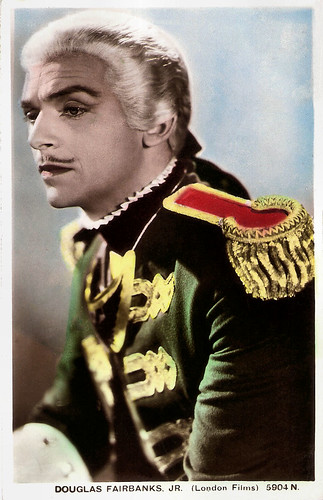
British postcard by Valentine's, no. 5904 N. Photo: London Films. Publicity still for The Rise of Catherine the Great (Paul Czinner, 1934) with Douglas Fairbanks Jr.
The Rise of Catherine the Great (Paul Czinner, 1934) is a straightforward biography of the Russian empress, up to her assumption of the throne. It was based on the play The Czarina by two Hungarian writers, Lajos Bíró and Melchior Lengyel.
In 1745 a German princess, Princess Sophie Auguste Frederika of Anhalt-Zerbst (Elisabeth Bergner), is summoned by Russian Empress Elizabeth (Flora Robson) to marry her nephew, the Russian heir. Elizabeth chose Sophie because of dynastic claims to Swedish and Baltic territories of the Romanov Family dealing with their Holstein blood connections - connections that Anhalt-Zerbst shared.
The young princess arrives at the court of imperial Russia to marry Grand Duke Pyotr (Douglas Fairbanks Jr.), who later became Peter III. Sophie, renamed Yekaterina, generally rendered in English as Catherine, initially likes him. But Peter already displays signs of mental instability and a sharply misogynist streak.
Peter rejects Catherine on their wedding night, reacting to something innocently said by his French valet, claiming that she used feminine tricks to win him over. In time, though, Peter accepts her and they have a happy marriage for a while. Meanwhile, Catherine gains important experience of government from working as principal aide to the empress.
Peter's suspicious, unstable nature gradually estranges them, and he finds solace with pretty courtiers. Catherine invents her own fictitious lovers, to make her husband jealous, which temporarily improves matters. But accession to the throne brings out the worst in Peter. After the death of the old Empress, the danger for Catherine increases and she must learn to be very cunning in order to save herself from her insane royal husband.
In reality, Catherine and Peter's marriage lasted for seventeen years, but in the film this period is greatly telescoped and no mention is made of their children. Their son Paul eventually became Tsar after Catherine's death, even though he was nearly as mad as his father.
Peter ascended the throne in 1762. As the Tsar, he proved to be a disaster, and within a few months he was removed from power by a military coup, dying in mysterious circumstances shortly afterwards. The coup plotters invited Catherine to become Empress in her own right. Catherine became the Tsarina Catherine the Great and would rule over Russia for more than 30 years. She became a benign dictator, brought Russia into the modern world, implemented several reforms, and corresponded with Voltaire.
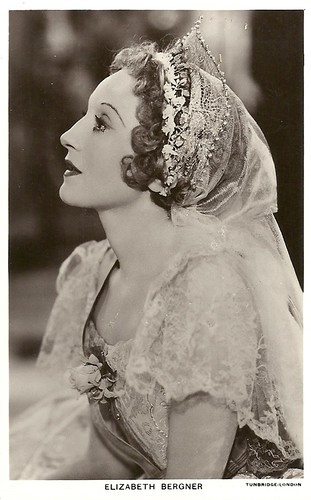
British postcard. Photo: Tunbridge, London. Publicity still for Catherine the Great (Paul Czinner, 1934).
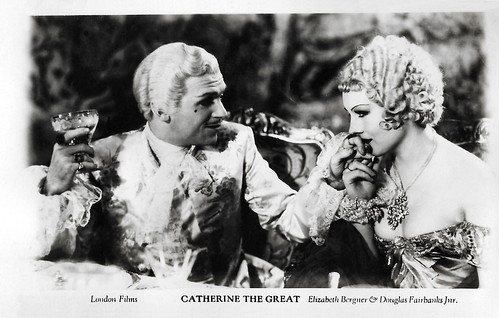
British postcard in the Filmshots series by Film Weekly. Photo: London Films. Publicity still for The Rise of Catherine the Great (Paul Czinner, 1934). Although the postcard credits the kissing lady as Elisabeth Bergner, we think she is Diana Napier who portrays Countess Vorontzova, the mistress of Peter III (Douglas Fairbanks Jr.).
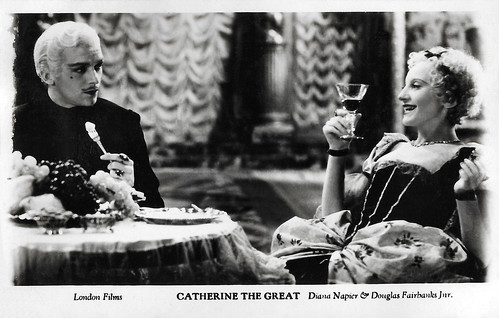
British postcard in the Filmshots series by Film Weekly. Photo: London Films. Publicity still for The Rise of Catherine the Great (Paul Czinner, 1934) with Douglas Fairbanks Jr. and Diana Napier.
The Rise of Catherine the Great (1934) was the first English-language film for Vienna-born Elisabeth Bergner. She is radiant as the obscure German princess who would become the most powerful woman in Russian history. Bergner definitely makes Catherine interesting and worth caring about.
As Grand Duke Peter - later Czar Peter III - Douglas Fairbanks Jr. behaves like a homicidal Hamlet, all moodiness and flares of deadly temper. He makes an interesting effort to create a charmer out of a pathetic man who was obviously a maniac.
The supporting cast is excellent. Dame Flora Robson is wonderful as the Empress Elizabeth: suspicious, domineering and rather wanton. Robson portrays Tsarina Elizabeth as a tired, dying woman, desperate to try to save the dynasty and her nation but aware of the rotten material she has to work with. She has the best lines and delivers them impressively.
Celebrated stage actress Dame Irene Vanbrugh makes a rare screen appearance as Catherine's mother. Vanbrugh was a stage star of the 1890s till the 1920s. She was in the original cast of The Importance of Being Earnest by Oscar Wilde. The small role of Peter's French valet is performed by Sir Gerald du Maurier, one of the great English actor-managers of the early days of the century. In this, his penultimate role, a few months from his death, Sir Gerald had become largely forgotten by his once enormous public. He gives his few lines great dignity.
The mid-eighteenth century was a period when clothes and furnishings favoured by the wealthy classes of Europe were particularly fanciful and elaborate, and this is reflected in the lavish sets and costumes on view in the film.
The Rise of Catherine the Great (1934) was overshadowed by the Hollywood epic The Scarlet Empress (1934), directed by Joseph Von Sternberg and starring a glamorous Marlene Dietrich. However, The Rise of Catherine the Great is still a good effort that is worth watching.
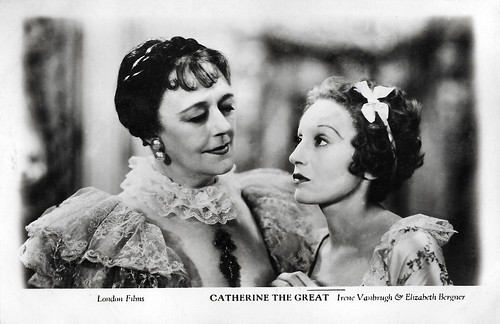
British postcard in the Filmshots series by Film Weekly. Photo: London Films. Publicity still for The Rise of Catherine the Great (Paul Czinner, 1934) with Irene Vanbrugh as Princess Anhalt-Zerbst, and Elisabeth Bergner.
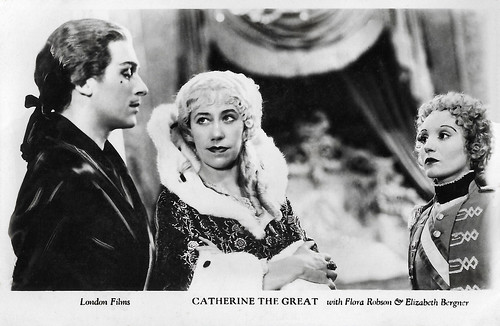
British postcard in the Filmshots series by Film Weekly. Photo: London Films. Publicity still for The Rise of Catherine the Great (Paul Czinner, 1934) with Douglas Fairbanks Jr., Flora Robson as Empress Elizabeth, and Elisabeth Bergner.
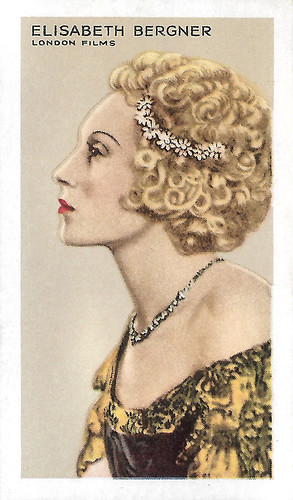
Elisabeth Bergner. British cigarette card in the Stars of Screen & Stage series by Park Drive Cigarettes, Gallaher Ltd., London & Belfast, no. 17. Photo: London Films. Publicity still for The Rise of Catherine the Great (Paul Czinner, 1934). Collection: Geoffrey Donaldson Institute.
Sources: Ron Oliver (IMDb), Wikipedia and IMDb.

British postcard by De Reszke Cigarettes, no. 24. Photo: British and Dominions. Publicity still for The Rise of Catherine the Great (Paul Czinner, 1934) with Elisabeth Bergner.

British postcard by Valentine's, no. 5904 N. Photo: London Films. Publicity still for The Rise of Catherine the Great (Paul Czinner, 1934) with Douglas Fairbanks Jr.
The way to the assumption of the throne
The Rise of Catherine the Great (Paul Czinner, 1934) is a straightforward biography of the Russian empress, up to her assumption of the throne. It was based on the play The Czarina by two Hungarian writers, Lajos Bíró and Melchior Lengyel.
In 1745 a German princess, Princess Sophie Auguste Frederika of Anhalt-Zerbst (Elisabeth Bergner), is summoned by Russian Empress Elizabeth (Flora Robson) to marry her nephew, the Russian heir. Elizabeth chose Sophie because of dynastic claims to Swedish and Baltic territories of the Romanov Family dealing with their Holstein blood connections - connections that Anhalt-Zerbst shared.
The young princess arrives at the court of imperial Russia to marry Grand Duke Pyotr (Douglas Fairbanks Jr.), who later became Peter III. Sophie, renamed Yekaterina, generally rendered in English as Catherine, initially likes him. But Peter already displays signs of mental instability and a sharply misogynist streak.
Peter rejects Catherine on their wedding night, reacting to something innocently said by his French valet, claiming that she used feminine tricks to win him over. In time, though, Peter accepts her and they have a happy marriage for a while. Meanwhile, Catherine gains important experience of government from working as principal aide to the empress.
Peter's suspicious, unstable nature gradually estranges them, and he finds solace with pretty courtiers. Catherine invents her own fictitious lovers, to make her husband jealous, which temporarily improves matters. But accession to the throne brings out the worst in Peter. After the death of the old Empress, the danger for Catherine increases and she must learn to be very cunning in order to save herself from her insane royal husband.
In reality, Catherine and Peter's marriage lasted for seventeen years, but in the film this period is greatly telescoped and no mention is made of their children. Their son Paul eventually became Tsar after Catherine's death, even though he was nearly as mad as his father.
Peter ascended the throne in 1762. As the Tsar, he proved to be a disaster, and within a few months he was removed from power by a military coup, dying in mysterious circumstances shortly afterwards. The coup plotters invited Catherine to become Empress in her own right. Catherine became the Tsarina Catherine the Great and would rule over Russia for more than 30 years. She became a benign dictator, brought Russia into the modern world, implemented several reforms, and corresponded with Voltaire.

British postcard. Photo: Tunbridge, London. Publicity still for Catherine the Great (Paul Czinner, 1934).

British postcard in the Filmshots series by Film Weekly. Photo: London Films. Publicity still for The Rise of Catherine the Great (Paul Czinner, 1934). Although the postcard credits the kissing lady as Elisabeth Bergner, we think she is Diana Napier who portrays Countess Vorontzova, the mistress of Peter III (Douglas Fairbanks Jr.).

British postcard in the Filmshots series by Film Weekly. Photo: London Films. Publicity still for The Rise of Catherine the Great (Paul Czinner, 1934) with Douglas Fairbanks Jr. and Diana Napier.
A homicidal Hamlet
The Rise of Catherine the Great (1934) was the first English-language film for Vienna-born Elisabeth Bergner. She is radiant as the obscure German princess who would become the most powerful woman in Russian history. Bergner definitely makes Catherine interesting and worth caring about.
As Grand Duke Peter - later Czar Peter III - Douglas Fairbanks Jr. behaves like a homicidal Hamlet, all moodiness and flares of deadly temper. He makes an interesting effort to create a charmer out of a pathetic man who was obviously a maniac.
The supporting cast is excellent. Dame Flora Robson is wonderful as the Empress Elizabeth: suspicious, domineering and rather wanton. Robson portrays Tsarina Elizabeth as a tired, dying woman, desperate to try to save the dynasty and her nation but aware of the rotten material she has to work with. She has the best lines and delivers them impressively.
Celebrated stage actress Dame Irene Vanbrugh makes a rare screen appearance as Catherine's mother. Vanbrugh was a stage star of the 1890s till the 1920s. She was in the original cast of The Importance of Being Earnest by Oscar Wilde. The small role of Peter's French valet is performed by Sir Gerald du Maurier, one of the great English actor-managers of the early days of the century. In this, his penultimate role, a few months from his death, Sir Gerald had become largely forgotten by his once enormous public. He gives his few lines great dignity.
The mid-eighteenth century was a period when clothes and furnishings favoured by the wealthy classes of Europe were particularly fanciful and elaborate, and this is reflected in the lavish sets and costumes on view in the film.
The Rise of Catherine the Great (1934) was overshadowed by the Hollywood epic The Scarlet Empress (1934), directed by Joseph Von Sternberg and starring a glamorous Marlene Dietrich. However, The Rise of Catherine the Great is still a good effort that is worth watching.

British postcard in the Filmshots series by Film Weekly. Photo: London Films. Publicity still for The Rise of Catherine the Great (Paul Czinner, 1934) with Irene Vanbrugh as Princess Anhalt-Zerbst, and Elisabeth Bergner.

British postcard in the Filmshots series by Film Weekly. Photo: London Films. Publicity still for The Rise of Catherine the Great (Paul Czinner, 1934) with Douglas Fairbanks Jr., Flora Robson as Empress Elizabeth, and Elisabeth Bergner.

Elisabeth Bergner. British cigarette card in the Stars of Screen & Stage series by Park Drive Cigarettes, Gallaher Ltd., London & Belfast, no. 17. Photo: London Films. Publicity still for The Rise of Catherine the Great (Paul Czinner, 1934). Collection: Geoffrey Donaldson Institute.
Sources: Ron Oliver (IMDb), Wikipedia and IMDb.
No comments:
Post a Comment